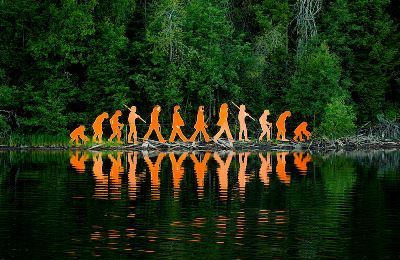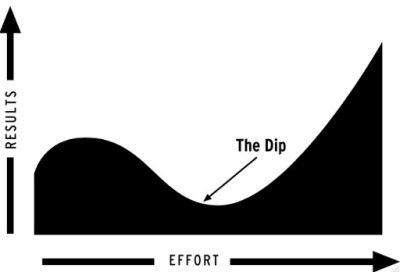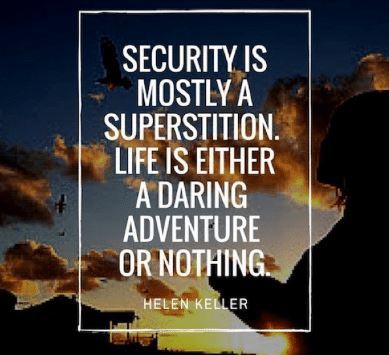Jeremie Averous's Blog, page 13
May 22, 2021
How Timescales of Survival Call on Different Groups
Survival at different time scales (year, decades, centuries, millenia) requires the mobilisation of different groups. This can explain the importance for us to cultivate those groupes (from the family to humankind). And this can also be contradictory therefore leading to paradox and conflict.

This thought is based on the quote by mathematician and physicist Freeman Dyson: “The destiny of our species is shaped by the imperatives of survival on six distinct time scales. To survive means to compete successfully on all six time scales. But the unit of survival is different at each of the six time scales. On a time scale of years, the unit is the individual. On a time scale of decades, the unit is the family. On a time scale of centuries, the unit is the tribe or nation. On a time scale of millennia, the unit is the culture. On a time scale of tens of millennia, the unit is the species. On a time scale of eons, the unit is the whole web of life on our planet. Every human being is the product of adaptation to the demands of all six time scales. That is why conflicting loyalties are deep in our nature. In order to survive, we have needed to be loyal to ourselves, to our families, to our tribes, to our cultures, to our species, to our planet. If our psychological impulses are complicated, it is because they were shaped by complicated and conflicting demands.”
Survival at different time scales requires sometime contradictory approaches and relying on different social social groups. That may be something we do not sufficiently account for in our understanding of social tensions.
Hat-tip for the quote to Valeria Maltoni in ‘Fast Gets all our Attention. Slow Has all the Power‘
The post How Timescales of Survival Call on Different Groups first appeared on The Fourth Revolution Blog.
May 20, 2021
How Our Personal Brand Is Not What We Are Showing Off
In this excellent post ‘Personal Brand 2020 – Document The World (Not Yourself)‘, Mitch Joel makes the point that there is much confusion between personal brand and what we show on social media.

“Your personal brand is the quality of your work, your professional output, and how it has helped another organization (or individual) improve their current business situation (or how they think/operate).” And that’s not quite the same as what we show off or share on social media.
Mitch Joel then makes sure we understand the difference between personal brand and vanity: “Your personal brand is not vanity. It’s your thinking.”
Those that define well their personal brand and communicate accordingly will have clearer way of presenting themselves to the world. Let’s be strategic on this and not share whatever pleases. In the new world as in the previous one, building a personal brand requires thought and discipline.
Your personal brand is not your presence on social media. It is rather what value to bring forth to the world. There is a huge difference, and we all need to understand it.
The post How Our Personal Brand Is Not What We Are Showing Off first appeared on The Fourth Revolution Blog.
May 18, 2021
How We Increasingly Live In a Low Resolution World
With the advent of internet and the much increased usage of teleconferencing and social networks, we may have significantly decreased the resolution of our social interactions. This is of course quite a paradox in a world where we all seek higher resolution TV and screens.
[image error]Still, our human interrelationships are increasingly virtual and by this fact, significantly lower resolution than real, face-to-face interactions in a real-life environment, with all that is entailed in terms of informal interaction. And this is not going to be significantly improved by higher resolution video!
The same applies for social networks: what we post is usually just a subset of what happens in our lives, and thus gives out an image of significantly lower resolution than would have someone living with us.
There is thus quite an interesting contradiction between a world that seeks always higher resolution TVs to watch the world, and the diminishing resolution of our social interactions. How can we explain this contradiction? Is the race for higher resolution screens a way to compensate for lower resolution relationships?
Hat-tip to Valeria Maltoni’s ‘What is High Resolution, what is Low Resolution. Can we Tell?‘
The post How We Increasingly Live In a Low Resolution World first appeared on The Fourth Revolution Blog.[image error]May 15, 2021
How We Should Not Be Fooled by Greenwashing
In this interesting Fast Company article ‘Don’t be fooled by brands that do one good ethical thing, say economists‘, the issue of a particular form of company greenwashing is exposed. All companies want to highlight some ethical action or initiative, but sometimes this hides a whole set of quite inappropriate behaviors.

Greenwashing is a new term: “a form of marketing spin in which green PR (green values) and green marketing are deceptively used to persuade the public that an organization’s products, aims and policies are environmentally friendly.” (Wikipedia). And this seems to be quite widespread, at least more or less consciously.
Still, studies show that “A company touting its One Ethical Behavior will likely manipulate you into a purchase“. This is linked to a psychological aspect: “Understanding our minds’ tendency to accept one positive behavior is essential. It’s commonly used across advertising and politics to mask significant ethical issues.”
Be wary about greenwashing and the good deeds that are communicated by organizations and companies, it is quite essential to understand whether it is just superficial chatter or the reflect of a deep culture. And if that is the case, those organizations may be those that communicate the least!
Greenwashing is an issue nowadays and let’s not be fooled by superficial communication on good deeds, rather examine if ethical behavior is deeply rooted in the organization!
The post How We Should Not Be Fooled by Greenwashing first appeared on The Fourth Revolution Blog.
May 13, 2021
How the Habit Dip Is an Incredible Learning Opportunity
In this excellent post ‘The Habit Dip‘, Leo Babauta goes deeper at what happens in this unavoidable dip when one tries to learn a new skill or habit. And how this moment of despair is also an incredible opportunity to learn about oneself.

All changes are hard and most go through a dip: after the initial excitement of discovering a new skill or habit, there is some sort of valley of death where progress is extremely difficult and disappointment can set in. It is the moment one should not abandon the change, and we all have to cross it.
Leo Babauta makes the point that “the dip is an incredible place of learning. It’s the place where we learn and grow, and get better at facing difficulty. When things are going well, everything seems easy, and you just have to keep doing the same thing. There isn’t a lot of learning there. But when things are hard, you have to face the difficulty if you want to keep going, if you want to avoid going to your usual pattern of discouraging yourself or quitting.“
Therefore when we are faced with this unavoidable moment, it is a good thing to become introspective and to analyze what happens to oneself. Being curious and in the learning mode will teach you much about yourself.
We all go through the dip when we try to change. It can be a struggle, but also a great learning moment about oneself. Let’s exploit it that way!
The post How the Habit Dip Is an Incredible Learning Opportunity first appeared on The Fourth Revolution Blog.
May 11, 2021
How Security is Mostly a Superstition
I like this quote by Helen Keller: “Security is mostly a superstition. It does not exist in nature, nor do the children of men as a whole experience it. Avoiding danger is no safer in the long run than outright exposure. Life is either a daring adventure, or nothing“.

This quote brings forth several aspects. The first is that security is a superstition, and although we strive for it and try to get it in modern society, we need to be aware that this is not a natural situation and should be careful not to become too naive.
This immediately brings logically the fact that it is not good to constantly avoid danger. While one can be prudent, it is quite useful to be adventurous.
And in any case, being adventurous brings us new discoveries and enlightens our lives.
Definitively, security is a not a natural state and we should not let ourselves become complacent. Life needs to be an adventure.
The post How Security is Mostly a Superstition first appeared on The Fourth Revolution Blog.
May 8, 2021
How Most Companies Play a Finite Game in an Infinite Game World
In his highly recommended book ‘The Infinite Game‘, Simon Sinek makes the point that whereas we live in a world of infinite games, most companies today play a finite game. And this is not getting better in the last years.
 1191856584
1191856584“Sadly , over the course of the past thirty to forty years, finite – minded leadership has become the modern standard in business. Finite – minded leadership is embraced by Wall Street and taught in business schools. At the same time, the life span of companies appears to be getting shorter and shorter. According to a study by McKinsey, the average life span of an S & P 500 company has dropped over forty years since the 1950s, from an average of sixty – one years to less than eighteen years today.”
It is quite amazing to have such a contradiction between a much more open, infinite game in business and economy with globalisation, and the fact that the financial markets promote finite game behavior. This also explains in a certain way the comparative success of fmily-driven businesses that take a long view on their development.
Let’s hope that with the development of sustainability thoughts, more economic players will start playing infinite games and that this finite-game behavior will change. This is definitely what is needed for the Collaborative Age.
The post How Most Companies Play a Finite Game in an Infinite Game World first appeared on The Fourth Revolution Blog.
May 6, 2021
How We Should Have a Diversified Portfolio of Gigs
In the interesting book ‘The Gig Economy‘ by Diane Mulcahy, she describes how we all should develop a diversified portfolio of gigs to succeed in this new economy.

“Diversifying our work reduces our risk, opens up new opportunities, expands our networks, and develops our skills. Diversifying our interests brings balance and variety to our lives and gives us a way to explore our passions, nurture new interests, and satisfy our curiosities.“
Her point is that in this portfolio, we should have profitable gigs and also gigs we don’t do for money – at least for now – and serve as exploration. “They could accomplish personal and professional goals and achieve a balance between money and love, play and work, passion and pragmatism“.
Some of those gigs should be pilots gigs we use as test benches: “Having a portfolio of gigs allows us to create low – risk opportunities to experiment with new ideas and new opportunities. An experimental gig lets us test an opportunity and if we find we don’t like it, we can drop it and try something else. By using gigs to create small pilot tests of opportunities, we create the option to either continue and invest more if it’s successful or stop and move onto something else if it’s not.”
Having a diversified set of interests and activities (gigs) appears to be a key to risk management and success in the new gig economy. What about you? Do you have such a portfolio including some pilot or emerging activities?
The post How We Should Have a Diversified Portfolio of Gigs first appeared on The Fourth Revolution Blog.
May 4, 2021
How Cities Need a Minimum Size for the Knowledge Economy
This Quartz piece ‘What it takes for a city to jump into the knowledge economy‘ mentions an interesting study to determine the critical size of a city to fully be involved in the knowledge economy: 1.2 million inhabitants.

This is based on studies carried out on a sample of hundreds of metropolitan areas, looking at people occupations. Statistics show a definite increase of knowledge workers above this threshold.
“In addition to more white-collar, higher-paying jobs, a bigger population leads to a more diversified economy, which in turn leads to innovation” In addition, the network effect created by the metropolis does help ideas being exchanged and innovation to be fostered.
This is quite interesting as it tends to show that there is a critical mass for the Collaborative Age metropolis to be fully embedded in the digital innovation. 1.2 million people is a relatively high threshold that makes may local towns seemingly less adequate to be a center of Collaborative Age value.
The post How Cities Need a Minimum Size for the Knowledge Economy first appeared on The Fourth Revolution Blog.
May 1, 2021
How to Motivate People in AI Environments
Motivating people working in AI-rich environments (where many operations are actually driven by AI) is a new challenge. Some researchers work on this issue though, as explained in this interesting Fast Company article ‘Why organizations might want to design and train less-than-perfect AI‘

While it is clear that in the future, value will be created by close collaboration between humans (very strong for creative tasks) and AI (very strong for repetitive tasks). Refer to our post ‘How We Need to Learn to Work with AI‘ for example. What is new here is the idea that AI itself must be adapted to fit this human interaction in the way it behaves.
“Giving too much authority to AI systems can unintentionally reduce human motivation.” How can we retain motivation? According to some Stanford research, the trick is to rely on the fact that “decision-making authority incentivizes employees to work hard“. Therefore, “there may be times when—even if the AI can make a better decision than the human—you might still want to let humans be in charge because that motivates them to pay attention“
The deal is not to have the best AI, but a slightly imperfect AI or an AI that asks humans for directions and instructions are well timed moments may be the best approach for a harmonious human interface.
The post How to Motivate People in AI Environments first appeared on The Fourth Revolution Blog.



